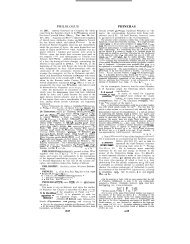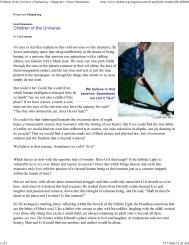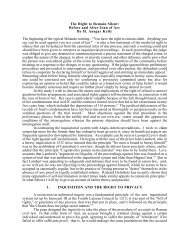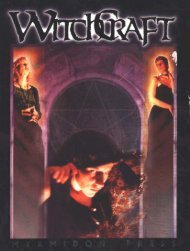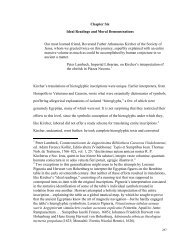THE SIMPLE ART OF MURDER by Raymond Chandler Copyright ...
THE SIMPLE ART OF MURDER by Raymond Chandler Copyright ...
THE SIMPLE ART OF MURDER by Raymond Chandler Copyright ...
You also want an ePaper? Increase the reach of your titles
YUMPU automatically turns print PDFs into web optimized ePapers that Google loves.
this must suggest Mark. Milne therefore works like a switch engine to put over the motivation that Mark is such a thoroughly conceited<br />
performer that he dresses the part down to the socks and underwear (from all of which the secretary has removed the maker's labels),<br />
like a ham blacking himself all over to play Othello. If the reader will buy this (and the sales record shows he must have), Milne figures<br />
he is solid. Yet, however light in texture the story may be, it is offered as a problem of logic and deduction.<br />
If it is not that, it is nothing at all. There is nothing else for it to be. If the situation is false, you cannot even accept it as a light novel,<br />
for there is no story for the light novel to be about. If the problem does not contain the elements of truth and plausibility, it is no problem;<br />
if the logic is an illusion, there is nothing to deduce. If the impersonation is impossible once the reader is told the conditions it must<br />
fulfill, then the whole thing is a fraud. Not a deliberate fraud, because Milne would not have written the story if he had known what he was<br />
up against. He is up against a number of deadly things, none of which he even considers. Nor, apparently, does the casual reader, who<br />
wants to like the story--hence takes it at its face value. But the reader is not called upon to know the facts of life when the author does<br />
not. The author is the expert in the case.<br />
Here is what this author ignores:<br />
1. The coroner holds formal jury inquest on a body for which no legal competent identification is offered. A coroner, usually in a big<br />
city, will sometimes hold inquest on a body that cannot be identified, if the record of such an inquest has or may have a value (fire,<br />
disaster, evidence of murder). No such reason exists here, and there is no one to identify the body. Witnesses said the man said he<br />
was Robert Ablett. This is mere presumption, and has weight only if nothing conflicts with it. Identification is a condition precedent to an<br />
inquest. It is a matter of law. Even in death a man has a right to his own identity. The coroner will, wherever humanly possible, enforce<br />
that right. To neglect it would be a violation of his office.<br />
2. Since Mark Ablett, missing and suspected of the murder, cannot defend himself, all evidence of his movements before and after<br />
the murder is vital (as also whether he has money to run away on); yet all such evidence is given <strong>by</strong> the man closest to the murder and<br />
is without corroboration. It is automatically suspect until proved true.<br />
3. The police find <strong>by</strong> direct investigation that Robert Ablett was not well thought of in his native village. Somebody there must have<br />
known him. No such person was brought to the inquest. (The story couldn't stand it.)<br />
4. The police know there is an element of threat in Robert's supposed visit, and that it is connected with the murder must be<br />
obvious to them. Yet they make no attempt to check Robert in Australia, or find out what character he had there, or what associates, or<br />
even if he actually came to England, and with whom. (If they had, they would have found out he had been dead three years.)<br />
5. The police surgeon examines a body with a recently shaved beard (exposing unweathered skin) and artificially roughened hands,<br />
but it is the body of a wealthy, soft-living man, long resident in a cool climate. Robert was a rough individual and had lived fifteen years in<br />
Australia. That is the surgeon's information. It is impossible he would have noticed nothing to conflict with it.<br />
6. The clothes are nameless, empty, and have had the labels removed. Yet the man wearing them asserted an identity. The<br />
presumption that he was not what he said he was is overpowering. Nothing whatever is done about his peculiar circumstance. It is<br />
never even mentioned as being peculiar.<br />
7. A man is missing, a well-known local man, and a body in the morgue closely resembles him. It is impossible that the police<br />
should not at once eliminate the chance that the missing man is the dead man. Nothing would be easier than to prove it. Not even to<br />
think of it is incredible. It makes idiots of the police, so that a brash amateur may startle the world with a fake solution.<br />
The detective in the case is an insouciant amateur named Anthony Gillingham, a nice lad with a cheery eye, a nice little flat in town,<br />
and that airy manner. He is not making any money on the assignment, but is always available when the local gendarmerie loses its<br />
notebook. The English police endure him with their customary stoicism, but I shudder to think what the boys down at the Homicide<br />
Bureau in my city would do to him.<br />
There are even less plausible examples of the art than this. In _Trent's Last Case_ (often called the perfect detective story you have<br />
to accept the premise that a giant of international finance, whose lightest frown makes Wall Street quiver like a chihuahua, will plot his<br />
own death so as to hang his secretary, and that the secretary when pinched will maintain an aristocratic silence--the old Etonian in him,<br />
maybe. I have known relatively few international financiers, but I rather think the author of this novel has (if possible) known fewer.<br />
There is another one, <strong>by</strong> Freeman Wills Crofts (the soundest builder of them all when he doesn't get too fancy), wherein a murderer,<br />
<strong>by</strong> the aid of make-up, split-second timing and some very sweet evasive action, impersonates the man he has just killed and there<strong>by</strong><br />
gets him alive and distant from the place of the crime. There is one <strong>by</strong> Dorothy Sayers in which a man is murdered alone at night in his<br />
house <strong>by</strong> a mechanically released weight which works because he always turns the radio on at just such a moment, always stands in<br />
just such a position in front of it, and always bends over just so far. A couple of inches either way and the customers would get a rain<br />
check. This is what is vulgarly known as having God sit in your lap; a murderer who needs that much help from Providence must be in<br />
the wrong business.<br />
And there is a scheme of Agatha Christie's featuring M. Hercule Poirot, that ingenious Belgian who talks in a literal translation of<br />
school-boy French. By duly messing around with his "little gray cells" M. Poirot decides that since nobody on a certain through sleeper<br />
could have done the murder alone, everybody did it together, breaking the process down into a series of simple operations like<br />
assembling an egg beater. This is the type that is guaranteed to knock the keenest mind for a loop. Only a halfwit could guess it.<br />
There are much better plots <strong>by</strong> these same writers and <strong>by</strong> others of their school. There maybe one somewhere that would really<br />
stand up under close scrutiny. It would be fun to read it, even if I did have to go back to page 47 and refresh my memory about exactly<br />
what time the second gardener potted the prize-winning tea-rose begonia. There is nothing new about these stories and nothing old.<br />
The ones I mentioned are all English because the authorities, such as they are, seem to feel that the English writers had an edge in this<br />
dreary routine and that the Americans, even the creator of Philo Vance, only make the Junior Varsity.<br />
This, the classic detective story, has learned nothing and forgotten nothing. It is the story you will find almost any week in the big<br />
shiny magazines, handsomely illustrated, and paying due deference to virginal love and the right kind of luxury goods. Perhaps the<br />
tempo has become a trifle faster and the dialogue a little more glib. There are more frozen daiquiris and stingers and fewer glasses of<br />
crusty old port, more clothes <strong>by</strong> Vogue and décors <strong>by</strong> _House Beautiful_, more chic, but not more truth. We spend more time in Miami<br />
hotels and Cape Cod summer colonies and go not so often down <strong>by</strong> the old gray sundial in the Elizabethan garden.<br />
But fundamentally it is the same careful grouping of suspects, the same utterly incomprehensible trick of how somebody stabbed<br />
Mrs. Pottington Postlethwaite III with the solid platinum poniard just as she flatted on the top note of the "Bell Song" from Lakmé in the<br />
presence of fifteen ill-assorted guests; the same ingenue in fur-trimmed pajamas screaming in the night to make the company pop in<br />
and out of doors and ball up the timetable; the same moody silence next day as they sit around sipping Singapore slings and sneering<br />
at each other, while the flatfeet crawl to and fro under the Persian rugs, with their der<strong>by</strong> hats on.<br />
Personally I like the English style better. It is not quite so brittle and the people as a rule just wear clothes and drink drinks. There is<br />
more sense of background, as if Cheesecake Manor really existed all around and not just in the part the camera sees; there are more<br />
3



